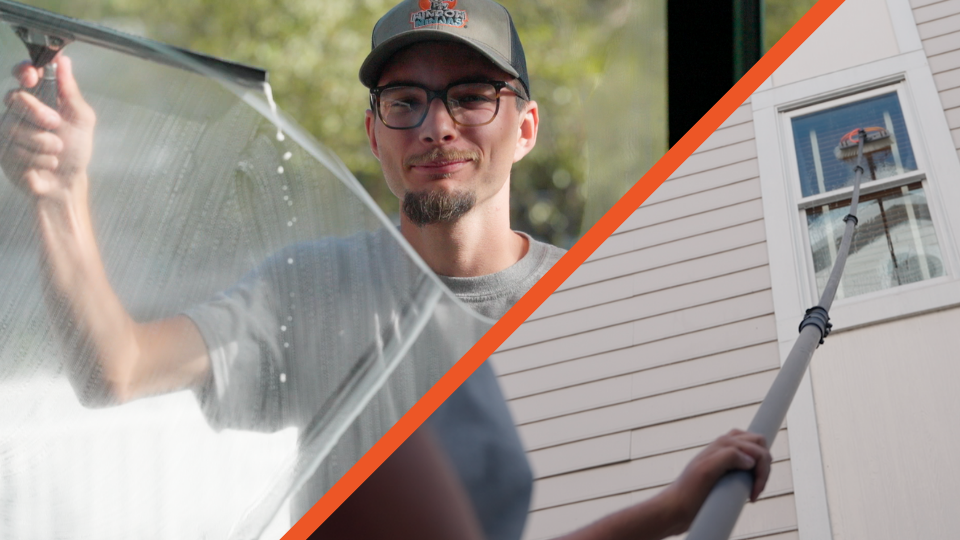Today, the window cleaning industry sits at an exciting crossroads, where tradition and technology meet to revolutionize the way we work. From automated equipment to advanced cleaning formulas, the possibilities for improving results, boosting efficiency, and prioritizing safety have never been greater. But as we lean into innovation, it’s critical to remember that traditional methods must remain a foundational element in the professional window cleaner’s toolkit. Technology is utterly amazing! That is, until it’s not. When technology fails, having mastered the old ways ensures you’ve always got a backup plan.
Technology’s Bright Promise
Over the years, modern technology has completely shaken up the way window cleaners tackle our craft. Take water-fed pole systems, for example. These bad boys allow us to clean windows safely from the ground, cutting down on ladder-related mishaps while still reaching impressive heights. Plus, with purified water delivering streak-free results, it’s become a real game changer. It’s no wonder they’ve become the go-to for anyone looking to boost efficiency without breaking a sweat.
And let’s not forget the magic of computer-aided scheduling and route optimization software. With just a few clicks, you can streamline job orders, calculate drive times, and manage crew assignments in real time. It’s like having a personal assistant who never takes a coffee break.
Now, if you’ve dipped your toes into drone technology, you know it’s opened up a whole new world. Especially for those massive commercial projects. We’re talking about a third tier of cleaning here: mop and glass, water-fed poles, and now, ground-level drone commanders directing their flying machines to tackle windows hundreds of feet in the air. It’s like the future of window cleaning has officially arrived!
A Word of Caution
Technology is amazing… until it’s not! Take water-fed poles, for example. They’re a total game changer, no doubt about it. But the moment your pump starts throwing sparks like a firecracker on the Fourth of July, or your DI filters fall apart faster than sand dunes in a hurricane, all that efficiency goes straight out the window. Literally. Now you’re left blowing bubbles and scrambling for a backup plan.
And how about software? Oh sure, those tech-savvy updates and patches make schedules smooth as butter—when they work. But one little glitch and suddenly you’re back at square one, staring at the screen like it’s a messy kindergarten art project. Reboot? Restart? Re-pray? Been there.
Now, drones… don’t even get me started on drones! These 21st-century marvels are incredible, right? Flying high, making life easier, until the battery decides it’s done in the middle of a job. What do you do then? Chasing a grounded drone across the job site isn’t exactly the picture of professionalism.
If you’ve experienced any of these tech tantrums in real-time, you know the pain. We’ve all been there. You’re on-site, looking at a massive to-do list of windows, and next thing you know, your fancy tech solution fails spectacularly. It wipes out your game plan faster than a home run shatters a pitcher’s no-hitter dreams.
Thanks a lot, Captain Tech Failure! But hey, we adapt, we learn, and we keep moving because, at the end of the day, nothing beats a little elbow grease and a backup plan.
So what’s your plan B?
This is where your mastery of old-school techniques can make or break the day.
Why the Old Ways Still Matter
Traditional methods aren’t just the backup plan. Nope, not even close. You and I both know they’re the heart and soul of this trade. They’re all about the skill and craftsmanship that separate the pros from the rookies.
Take squeegee skills, for example. Mastering those smooth, flawless strokes isn’t just a rite of passage. It’s an absolute must. A perfectly executed squeegee pass is like a signature of excellence. You can spot it from a mile away, and it never goes out of style. Whether you’re wrist-deep cleaning individual panes on a storefront or tackling an 80-story high-rise with 10-foot-wide glass plates, traditional tools like squeegees, window scrapers, and detailing cloths are key. They deliver top-quality results every single time. No batteries, no software updates, just dependable, tried-and-true tools that get the job done.
Rope access techniques are another skill that’s as timeless as they come. Sure, safety harnesses have gotten comfier and more high-tech over the years, but the core principles have stayed the same. It’s all about controlled descents, steady movements, and laser focus. When you’re swinging dozens of stories above ground, nothing can replace the precision of a trained pro. Fancy drones might be able to fly high, but they’re never going to match the finesse of someone who knows their way around a rope.
And speaking of drones and water-fed poles, don’t get me wrong, they’re great tools. But they come with limits. That drone isn’t going to spot the sneaky water intrusion issue on the fifth floor of the mid-rise you’re tackling this weekend. No camera can pick up on that hidden flaw like a trained eye using traditional methods can. And if you miss it, how much is that going to cost you? Lost revenue on a glazing repair? Or even worse, being held responsible for the water damage? That’s a headache no one wants.
At the end of the day, technology is helpful, but it’s craftsmanship and skill that keep this industry thriving. And those are qualities no gadget will ever replace.
A Reminder to Stay Grounded
Window cleaning demands physical precision, mental focus, and adaptability, and that’s not changing anytime soon. It isn’t about choosing between technology and tradition—it’s about weaving both together to create a stronger, more resilient process. At its core, this industry is about craftsmanship, and while the tools may evolve, the cleaner’s skill remains the driving force behind every successful job.
Every innovation in our industry is an invitation to grow, and as we clean into the future, don’t forget the value of where we’ve been. Master those traditional methods, keep a cool head when tech inevitably hits a snag, and remember that it’s how you master our profession, not just the tool in your hand And that is what truly sets you apart.

